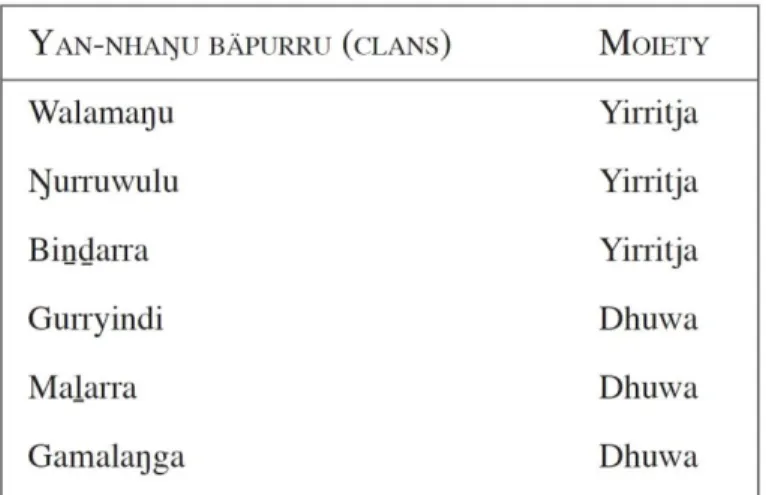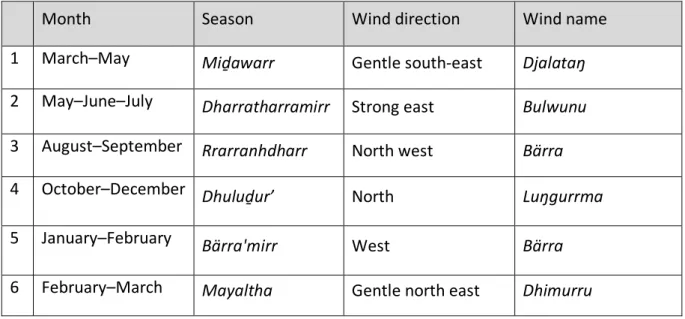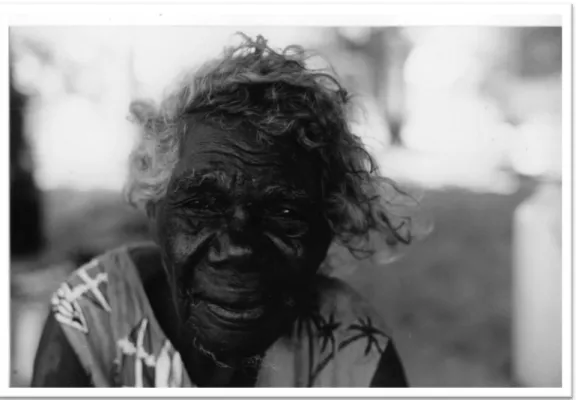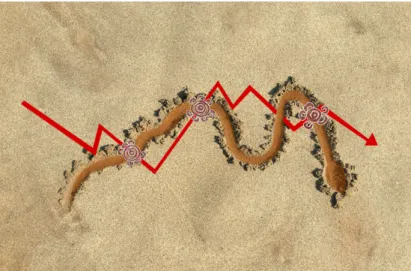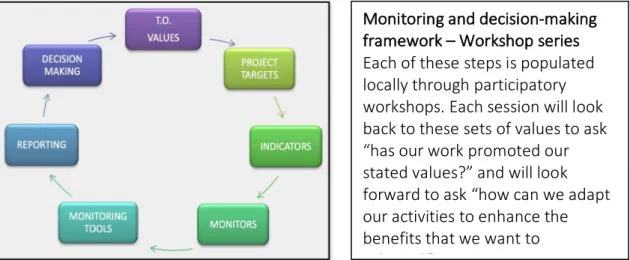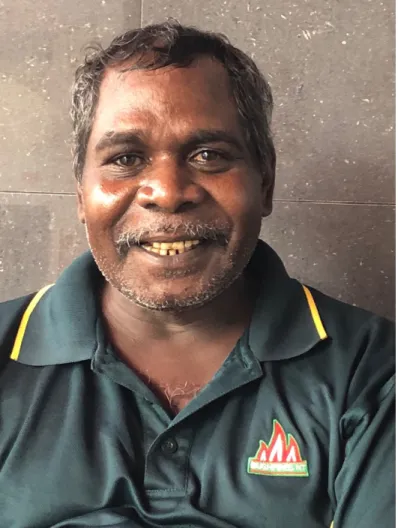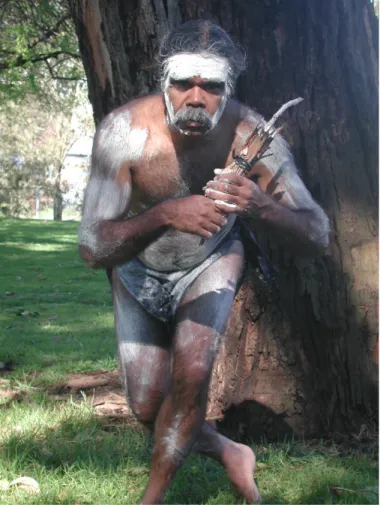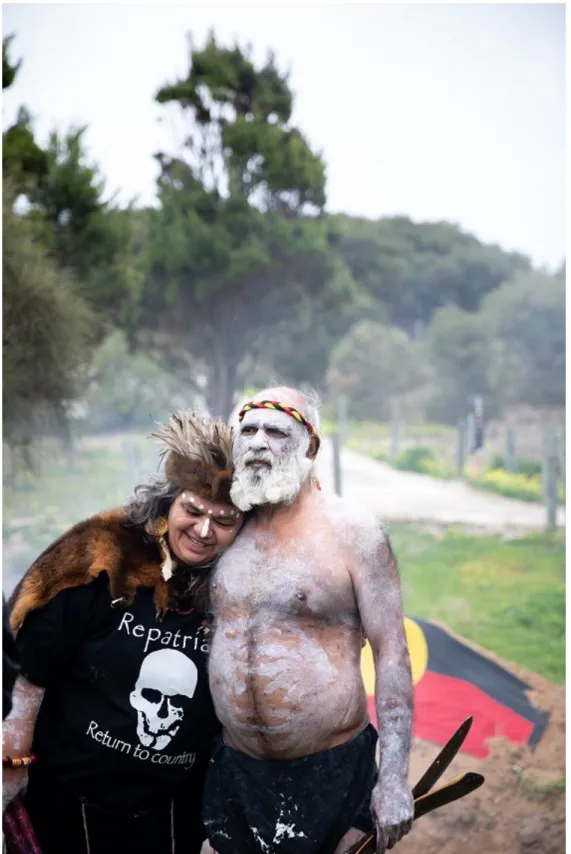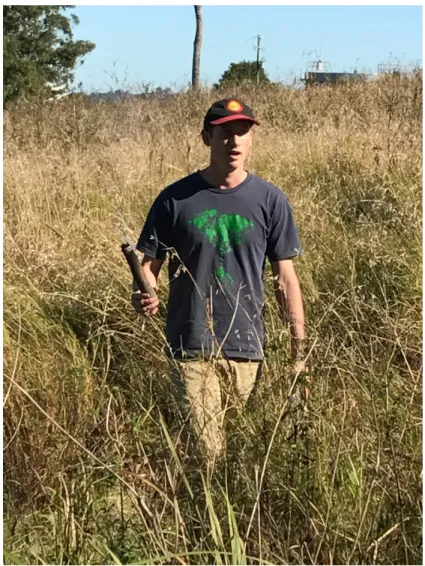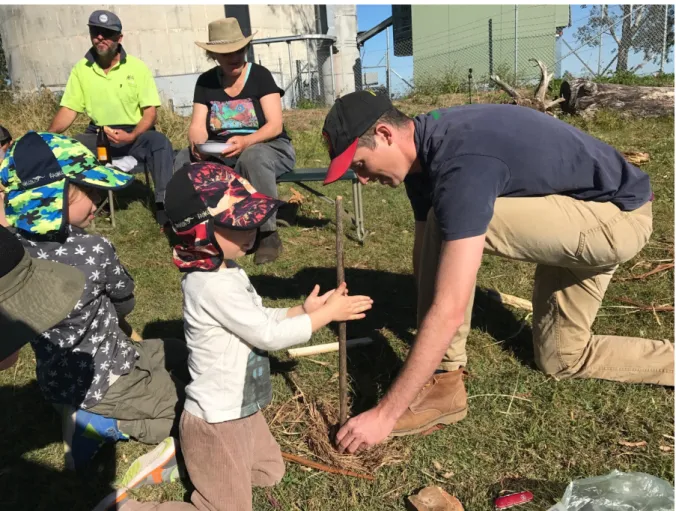Fire, Water and Land in Indigenous Australia
Edited by
Marie Carla D. Adone
Melanie A. Brück
ã Copyright 2019 Marie Carla D. Adone and Melanie A. Brück, University of Cologne First Edition
Printed in Germany by University of Cologne Press
Editors: Marie Carla D. Adone and Melanie A. Brück Cover design: Thomas Batchelor
Photograph taken by Marie Carla D. Adone
All rights reserved. No part of this publication may be reproduced without prior written permission of the publishers
Acknowledgments to the Traditional Owners and Custodians
We acknowledge the Traditional Owners and Custodians across the land on which we conducted work. We pay our respects to the Elders of all languages referred to in this work,
both past and present.
Acknowledgments
The impetus for this book comes from the proclamation of 2019 as the Year of Indigenous Languages. The editors thank all the Indigenous people who were involved directly and indirectly in the process of making this book. We would like to acknowledge their work, support and dedication. We are very grateful that many people shared knowledge on their language and culture with us. Discussion on these chosen topics has been challenging at times but it is rewarding in that it promotes understanding of Indigenous views which are often seen as opposing western scientific views. This book is the tangible product of close and long- standing collaborations between Indigenous and Non-Indigenous researchers over the years.
We would like to thank all the contributors for the insights they offer in their respective fields and for their co-operation. Our heartfelt gratitude goes to our colleagues Dr. Bentley James, Dr. Doug Marmion, Dr. Knut Olawsky and Prof. Jacky Troy who encouraged us and gave us their support. We are very grateful to the editing team: Mareike Plenk, Anja Steger, Thomas Batchelor, Sandra Ringsmut and Kathrin Brandt. We also thank the reviewers who ensured the academic quality of the contributions.
Introduction ... 1 Marie Carla D. Adone and Melanie A. Brück
Saltwater Burning ... 5 Glenn James and Bentley James
“Country Services People, not People Service Country” ... 33 Anthony Kerr
The Role of Land, Fire and Water in the Kaurna Cultural and Linguistic Renaissance ... 43 Rob Amery and Katrina Karlapina Power
“Cultural Burning: The Way Forward for Healthy Landscapes” ... 66 Anthony Kerr
“Caring for dat land…, as mob bin teik keya of dat Kantri longtaim” ... 81
Marie Carla D. Adone, Thomas Batchelor, Rozanne Bilminga, Melanie A. Brück, Bryan Gallagher and Jimmy Paddy
River(s) of Resistance ... 98 David Kern
The Contributors ... 114
Introduction
Marie Carla D. Adone and Melanie A. Brück
The year 2019 has been proclaimed the International Year of Indigenous Languages. The main aim was to raise awareness on the fact that Indigenous languages are disappearing as well as the need to promote, preserve, and save these languages. Furthermore, measures were taken both at the national and international levels with the collaboration of a number of agencies to improve the situation. Australia has been identified to have “experienced the greatest and most rapid loss of languages over the last century” (Koch and Nordlinger 2014: 4). Of the approximately 250 or more languages spoken in 1788, only 15 to 18 are transmitted to the next generation of children as first languages. The remaining 100 or so languages have a small number of elderly speakers (Marmion, Obata and Troy 2014). As language and culture are closely intertwined, the disappearance of Indigenous languages also results in the disappearance of Indigenous Knowledge.
One of the three major pillars of the Centre for Australian Studies (henceforth CAS) at the University of Cologne rests on Indigenous Studies. The Centre sees itself as an agency which promotes studies on Indigenous languages and knowledge in Australia among others, with a special interest on the issue of language endangerment and loss. As such, this book should be regarded as a contribution of the CAS to celebrate the International Year of Indigenous Languages. It raises awareness, promotes and supports work on Indigenous matters.
In this respect, this publication highlights the richness of Indigenous linguistic and
cultural Knowledge by focusing on three themes vital to life: Fire, Water and Land. These
themes are deeply connected to each other in the ecological Knowledge systems of
Indigenous Australians. Furthermore, humans and nature are interconnected. Human beings
are seen as part of the ecosystems and cannot be fully grasped or managed if separated from
it. This view is implicit in the Indigenous concept of Country. By focussing on the role played
by fire, water and land in Indigenous Australia we aim to achieve a better understanding of
the complex nature of the interconnectedness between humans and nature which is reflected
in a broad array of cultural practices (e.g. environmental conservation, cultural governance, language revitalisation programmes, and documentation of sacred sites).
In this book we compiled six papers. Four of these papers are articles providing an overview of either one of the three themes or the three themes together. These contributions come from different angles including anthropology, linguistics, literary and cultural studies and geography. In addition, there are two interviews with two leading Indigenous leaders who represent the Indigenous voice on these themes.
Map 1: Location of Indigenous language groups represented in the contributions of this book.
In their article titled Saltwater Burning, Glenn James and Bentley James take a close look at
the Yan-nhaŋu speaking Yolŋu people. They are the traditional owners of the Crocodile Islands
in Australia’s Northern Territory. For eons, with the changing seasonal winds, Yan-nhaŋu and
kinsmen would travel the islands, visiting and refreshing ancestral powers in sacred sites,
gathering seasonally available resources, and burning the country. As the colonial state and
society encroach and the old people die this remarkable inheritance is at risk. Today, young
people ask “how can we ‘know’ when all those who know are gone?” Through the vision of
elder Laurie Baymarrwaŋga they provide a glimpse of how the Yan-nhaŋu approach to ‘caring
for their country’ is embedded in ancestral connection, language, ritual and song - how
burning saltwater country resonates with ancestral essence and yet is increasingly driven by
an emerging vision and economy of modern land and sea management. Amidst the manifest benefits of resourcing access to and management of sea country lays a tension with the continuity of Yan-nhaŋu life. Can this movement simultaneously offer the tools and means to help define the concerns of inevitable loss and assist Yan-nhaŋu sea managers bring those values, unique to their identity, with them into the challenging future?
In his interview with Otto Bulmaniya entitled
“Country Services People, not People Service Country”Anthony Kerr and Otto discuss fire management. In late November 2017 Anthony met with Otto Bulmaniya Campion, a senior Traditional Owner and a senior Gurruwilling Ranger at Ramingining. A decade before Otto had introduced Anthony to Arnhem Land and they have collaborated ever since on various natural resource management projects.
Otto who has been heavily involved in fire management in the Arafura Swamp region for many years, discusses in the interview some of the major land management and cultural challenges that he faces.
In the paper entitled “The Role of Land, Fire and Water in the Kaurna Cultural and
Linguistic Renaissance” Rob Amery,and Katrina Karlapina Power discuss the case of the Kaurna people of Adelaide and the Adelaide Plains in South Australia. Their language bore the brunt of colonisation in 1836. Within just 25 years Kaurna ceased to be spoken on an everyday basis as a result of a dramatic plummeting of the population and shift to English. Kaurna was documented soon after colonisation by two German missionaries. Their records reveal the importance of land, fire and water to Kaurna existence. These three elements not only provided the basics of life, but were highly significant spiritually. Furthermore, fire was used to shape the land which ensured a plentiful supply of game into the future. Kaurna is now undergoing a linguistic and cultural renaissance where contemporary people are turning back to their roots and are seeking justice and redress. Within this context Kaurna people seek recognition of their rights to land and water, whilst fire is playing an increasingly important ceremonial role. Many young Kaurna men have taught themselves the art of making fire by rubbing sticks together. Fire and smoke have re-emerged as important elements within funerals, return of human remains, cleansing rituals, welcomes and other forms of public performance.
In the interview entitled “Cultural Burning: The Way Forward for Healthy Landscapes”
Anthony Kerr talks to Oliver Costello. Oliver Costello is a Bundjalung man, and leads the
Firesticks Alliance Indigenous Corporation, which builds on the Firesticks Initiative he co-
founded in 2009 while completing university and the Centre for Sustainability Leadership Fellowship Program. In the interview Anthony and Oliver discuss the case of the Dorrobbee Grass Reserve where some burning was planned. Oliver also talks about his life and the route into fire management that he chose to take. One of the highlights in this interview is the discussion of Indigenous Knowledge of fire practices and its implementation combined with other governance systems.
In the paper “Caring for
dat land…, as mob bin teik keya of dat Kantri longtaim”:Indigenous Ecological Knowledge Reflected in Kununurra Kriol” Marie Carla D. Adone,
Thomas Batchelor, Rozanne Bilminga, Melanie A. Brück, Bryan Gallagher and Jimmy Paddy discuss how Indigenous Knowledge on the environment is reflected in Kununurra Kriol. In the Kununurra area of northern Western Australia, the Miriwoong people, similar to other Indigenous groups over the continent, have been caring for the land they have been living on for thousands of years. Since the arrival of Europeans on Miriwoong country in the 19
thcentury, however, colonial pressures have resulted in a gradual loss of the traditional Miriwoong language in the community. In its place, Kriol has arisen as the common lingua franca between Miriwoong community members in the Kununurra area. Whilst very few people speak the traditional Miriwoong language today, its role as the substrate language in the genesis of the local Kriol language is undeniable. This is witnessed not only in the lexicon but also in the cultural practices of the Miriwoong people.
The last paper entitled River(s) of Resistance – Narratives of Water and struggles for
“ex-colonialism” in the Work of Tony Birch is written by David Kern. In this paper Kern
explores the narrative figurations of water in the work of Indigenous Australian writer, scholar
and environmental activist Tony Birch. Offering a close-reading of selected aspects of his
second novel Ghost River (2015), he analyses how water can be understood as both a site as
well as agent of resistance, and he theorises how Tony Birch’s novel is an excellent case in
point of narrative fiction as an exit strategy from colonialism. What matters greatly in a time
called the Anthropocene, he suggests, is the question of inter-personal relationships and
issues of relationality in general. For this reason, he explores how relationship-based
decolonisation methodology and theory can be brought into productive conversation with
Ghost River. He concludes by ways of reflecting about the importance of place in general and
water in particular, in the context of decolonisation as a recovery and the formation of
equitable relationships.
Saltwater Burning
Glenn James and Bentley James
Dhäbiya naŋapuluma dhul’miyama waŋgalaŋa limalama?
Wanhaba, ŋupanaba romnha! (Baymarrwaŋa 1999)
‘Why do we burn saltwater country? It’s the law!’ (James 1999)
Saltwater burning
The Yan-nhaŋu speaking Yolŋu
1people are the traditional owners of the seas and islands of the Crocodile Islands of Castlereagh Bay in North East Arnhem Land in Australia’s Northern Territory. Since sea levels reached their present height between 5,000 to 8,000 years ago, these islands and the reefs, shoals and surrounding saltwater country are the ancestral home of the Yan-nhaŋu people. Below the seas this land has been the ancestral home to these people for 65,000 years. Known as saltwater people, the Yan-nhaŋu people speak the Yan- nhaŋu language their ancestors bestowed to them on their travels around the coasts, across the sea and the islands. As the ancestors travelled, they created and named special places in the Yan-nhaŋu language. This country is known as saltwater country. These special named places and sacred sites contain the spiritual essence and power of the ancestors. These places share the names, ancestral substance and metaphysical constituents of the people of the islands, a provenance bestowing an indissoluble bond and responsibility to care for kin and country. It is this bond that compels the people to burn the woodlands and coastal areas of their saltwater country in harmony with ancestral laws.
This remarkable inheritance is at risk. With the changing seasonal winds, the Yan- nhaŋu and their Yolŋu kinsmen would travel around this country visiting and refreshing the
1 Yolŋu (Yolngu) is a term used by Yolŋu people and researchers since the 1960s to describe the Indigenous people of North East Arnhem Land speaking languages called collectively Yolŋu-Matha (literally ‘people’s tongue’) and refers to a population of some 7,000 people. Earlier anthropological literature has referred to these people as the Yorngnar (Wilkins 1924), Murngin (Warner 1937), the Wulamba (Berndt 1951, 1952, 1955) and the Miwuyt (Shapiro 1981). According to Schebeck (1968), the term Yolŋu was introduced into the linguistics literature by O’Grady et al. (1966).
ancestral powers in sacred sites while gathering the rare and seasonally available resources that bless the land. This pattern of inter-island travel diminished after the coming of the mission. With the cessation of this pattern of seasonal travel and burning, beginning a century ago, the knowledge of managing their island estates began to be forgotten with the passing of older generations. Priceless ancestrally inherited knowledge arising from uncounted generations of intimate coexistence with the islands and marine environment is all but lost to current generations and to the world. This story offers a perspective on the current struggle to reclaim/rebuild this sacred knowledge and modes of intergenerational transmission.
Today young people ask, “how can we ‘know’ when all those with unique knowledge have passed?” Capturing this provincial challenge requires at least a glimpse of pre-contact life on the Crocodile Islands and a picture of resilience in the life of the people of the Crocodile Islands as they struggle to recreate the pattern of inter-island travel and burning of the Yan- nhaŋu ancestors. We seek to reveal what ‘caring for country’ and for the spirits of country might mean, through stories, by retelling stories that we have collected from the people of the Crocodile Islands in their Yan-nhaŋu language and in the more widely used Yolŋu-Matha language of North East Arnhem Land. In particular, we focus on one very special Yan-nhaŋu woman’s mission to give children back knowledge of their country and the language of their ancestors. In the vision and virtue of Laurie Baymarrwaŋa we find hope for the future. A vision of revivifying elemental links with the ancestral essences of the country, embedded in songs, stories and language, heard on the voice of the wind, in the songs of the birds, in the seasonal revisitation of spirits of country.
We then describe local management tools developed by a new generation of
contemporary land managers to pick up the threads of traditional fire regimes and retain the
metaphysical drivers of burning saltwater country. This work is critical as the number of old
people who are still alive to inform this process are declining quickly with the relentless march
of the settler state and the impact of its priorities in the production and movement of global
capital – in particular the so called neo-liberal state.
The Crocodile Islands
2.1. Where are the Crocodile Islands?
The Crocodile Islands are found at the most westerly edge of the Yolŋu language enclave (see Maps 1 and 2 below). At the beginning of last century, the coming of the Milingimbi Methodist Overseas Mission (MOM) heralded the Australian Settler State’s first formal physical occupation of Yolŋu country. Map 1 illustrates the extent of Arnhem Land and the major ex- mission communities and smaller homelands within the area in which Yolŋu languages are spoken. The Crocodile Islands region (Map 2) is in the North East part of greater Arnhem Land, an area of approximately fifty thousand square kilometres, and is the home to some eighty different languages (Cole 1979: 26).
Map 1: Arnhem Land, Northern Territory, Australia (James and Watkinson 2019).
The sea is focal to the Yan-nhaŋu way of life, as a physical space and a mental map inscribed
with ancestral meaning. The exclusively marine geography of their estates, structured
patterns of ritual, travel and the metaphysical drivers of what we might call marine resource
management, were all but wiped out with the coming of the mission. In more recent times
the familiar mechanisms of settler dispossession, of extraction, of lawful re-possession of land
and marine resources, of humanitarian aid by state intervention, of Responsibility to Protect,
have increased the destructive burden of the colonial legacy.
Map 2: Crocodile Islands and surrounding Arafura Sea, Northern Territory, Australia (James and Watkinson 1999, 2019).
The Yolŋu are comprised of about 60 or so clans or bäpurru and related language varieties forming a discrete linguistic community.
2This Yolŋu area encapsulates over one hundred distinct homelands, areas of deep spiritual attachment to the Yolŋu people who live there.
The link between language, people and land is of fundamental ontological significance in understanding the roots of Yolŋu, and therefore Yan-nhaŋu language affiliations. It is this language affiliation to land and kin that gives a fuller appreciation of contemporary attachment to sea country and life on the homelands, and the desire to burn the country.
2 Yolŋu languages described in Lowe (1957) are Dhuwala, Dhaŋu (Schebeck 1976), Gälpu (Wood 1978), Golpa (Zorc 1978) Ritharrŋu (Heath 1980), Djapu (Morphy 1983), Djinaŋ and Djinba (Waters 1989), Djambarrpuyŋu (Wilkinson 1991), Wangurri (McLellan 1992), Gupapuyŋu (Christie 1993, 2001), Nhangu (Kabisch-Lindenlaub 2017) and Yan-nhaŋu (James 1999, 2009, 2015, James et al. 2003 and Baymarrwaŋa and James 2014).
2.2. Yan-nhaŋu: people of the Crocodile Islands
The Yan-nhaŋu people are the traditional owners of the Crocodile Islands. Geographically speaking the Yan-nhaŋu language is the western-most of seven distinct and mutually unintelligible socio-linguistic varieties of the Yolŋu language family (Schebeck 1968: 10-11, Waters 1989, Zorc 1986, cf. Christie 2001). Yolŋu people speak a language they call Yolŋu- Matha, a Pama-Nyungan language which forms a discrete enclave surrounded by prefixing non-Pama-Nyungan languages. Yan-nhaŋu is one of some seven Yolŋu languages and has been described as a central and southern sub-group of the Northern Nhaŋu Yolŋu language (Schebeck 1968). Much has been written about the Yolŋu and their languages since Sir Hubert Wilkins gathered the first stories from Milingimbi in 1922. Milingimbi is the largest of the Inner Crocodile Islands on the sea country of the Yan-nhaŋu speaking people. From In 1926 to 1929 anthropologist Lloyd W. Warner collected the first comprehensive ethnography of the Yolŋu people on the Crocodile Islands.
Yan-nhaŋu language is a distinct language, but closely related to the northern Nhaŋu- mi language variety of the Wessel Islands.
3For the Yan-nhaŋu, the ancestral endowment of marine and island sites, and their language is a fundamental dimension of their identity. This endowment at once distinguishes them from, and simultaneously incorporates them, into the body of their Yolŋu kin from surrounding bäpurru, with mainland estates and languages. Yan- nhaŋu people are made up of six bäpurru. Yan-nhaŋu clans or bäpurru are divided equally into two moieties, Dhuwa or Yirritja (see Table 1 below). According to the Yan-nhaŋu everything in the universe is divided into two kinds. These halves or moieties are nominated Dhuwa and Yirritja.
4The three Dhuwa bäpurru
5– Gamalaŋga, Mäḻarra and Gurryindi
6– and the three Yirritja bäpurru – Walamaŋu, Biṉḏarra and Ŋurruwulu – are known as, and refer to themselves as, Mariŋa, ‘people of the sea’ (James et al. 2003, James 2009, Baymarrwaŋa and James 2014).
3 For a more complete explanation see James 2009: 170-179; Baymarrwaŋa and James 2014: 532-538.
4 Dhuwa and Yirritja are two halves, or moieties, of the Yolngu system of thought that divides the world into two categories, classifying every aspect of the physical and spiritual world. These moieties are characterised by complementary reciprocal relations understood to create the fundamental conditions for fertility and life.
5 The term clan is now usually replaced by the term bäpurru as it denotes a more complex meaning closer to Yolngu conceptions. Bäpurru have been described as complex, multilayered, focal social categories with a common identity, existing in shared ancestral essences (see Keen 1978, 1994, 1995, Toner 2001).
6 Malarra, Mäḻarra, Maḻarra, also known as the Mäḻarra/Guṉbirritji/Murruŋun, have been misnamed the Yan- nhaŋu. Yan-nhaŋu is a language name, there is no (clan) bäpurru called the Yan-nhaŋu, this is the name of the language inherited and spoken by the Mäḻarra, despite ongoing confusion by contemporary researchers (James et al. 2003, James 2009, Baymarrwaŋa and James 2014).
Table 1: Yan-nhaŋu Bäpurru and Moieties (Baymarrwaŋa and James 2014: 26).
There are close to 200 Yan-nhaŋu people. Most live in and around the communities of Maningrida, Milingimbi, Galiwin’ku and on the surrounding homelands such as Murruŋga, Rapuma and Yilan.
7There continues to be some discontinuity in the wider reference works on Yan-nhaŋu language and group identity and organisation. Two schools of thought have emerged. One school may best be described as the Yan-nhaŋu school; this includes the Yan- nhaŋu people and their description of themselves, in their language, as reproduced by James (1999, 2009, 2015, James et al. 2003, 2019). The other might best be characterised as the outsider’s view, that is, external reports about Yan-nhaŋu people. Those without the benefit of speaking Yan-nhaŋu, elide for various reasons the significant sensitivity of bäpurru identification with language and continue to muddle the model (Baymarrwaŋa and James 2014). Yan-nhaŋu language was not recorded by the Yan-nhaŋu and James until 1993 (James 1999). Confusion about Yan-nhaŋu group and language identity are common with the exception of Schebeck (1968).
8Ill-advised earlier misrecognition has continued to be reproduced by more recent researchers (Christie 2001, Kabisch-Lindenlaub 2017). Yan-nhaŋu people discourage such inaccuracy considering it disrespectful. It is well understood that for Yolŋu people correct recognition, definition and differentiation of proper names, language, place and bäpurru is critical to distinguishing groups, spiritual identity, and of the highest ritual, political and economic significance. Group identity is fundamentally a question of
7 In the Australian Indigenous context homelands are small communities where a number of families from various but related clans coexist, and where life, ritual and what we might not inaccurately call work, are organized around the management of land/sea country, concern for kinship, ancestral connections and local languages.
8 For example, Jennison (1927), Radcliffe-Brown (1930), Warner (1937), Tindale (1940), Capell (1942), Berndt and Berndt (1951), Berndt (1955).
ancestral bequest and spiritual inheritance. In this depiction we have deployed a more sensitive ethno-linguistic approach in favour of a finer grained and nuanced explication.
From a Yan-nhaŋu perspective their distinctive language and associated world view is an inviolable part of their spiritual, social and language identity. The coordinates of this identity emerge from, and harmonise with, an ancestrally inherited, kin-based view of the world – a view that rests on enduring links to a pre-existing network of ancestral sites, associated spiritual entities and the residues of their essences and power in their sea country (Morphy 2008, James 2015). The notions of universal kinship and an ancestral geography provide a key to talking about Yolŋu groups. Kinship patterns and an ancestrally inherited ontological frame of reference underwrite shared practices between people from different groups, speaking different languages. Within this space, Yolŋu kin living on Yan-nhaŋu sites share their community and practices on the seas and sites of the Crocodile Islands bequeathed by the Yan-nhaŋu ancestors.
Wind, water and fire: seasons of inter-island voyaging
Yan-nhaŋu mythology is full of seafarers who braved huge crocodiles and a pantheon of marine hazards on their journeys between the islands. These ancestral journeys were enacted on buoyant devices like the floating log, wuḏuku, and the insubstantial paper bark raft, djutu.
These smaller craft were rarely used for longer voyages, as truly gigantic crocodiles of six meters were and are still present. Donald Thomson (1937), who travelled to the outer islands in 1935, reports the construction of more robust canoes made of eucalyptus tree bark called ḏirrka at Murruŋga Island, capable of carrying ten people at a time. These ḏirrka canoes were made by sewing together layers of bark in a method called barrwan-mindapumaway and were up to four meters long. Thomson (1937) writes of their sea-worthiness and speed over rough water:
… the biggest of all are made at Mooroonga [Murruŋga] (yana:ngo matta, Yiritja, and Mandjikai malla) of two sheets of bark sewn together and in these the natives make journeys to Rabuma [Rapuma] and other islands of the Crocodile group, as well as to the mainland.
(Thomson fieldnotes, 7/1/1937 File No. 115)
A smaller bark canoe called the gal-gal was associated with travel over shorter distances
between the islands and the transport of marine resources. These two types of ancestrally
bequeathed bark canoe designs are quite distinct from the hollow log or dugout canoe (lipa-
lipa) of Macassan origin.
3.1. Winds and seasons of the Crocodile Islands
The reckoning of the seasons and their winds is at the heart of island time. Knowledge of the seasonal availability of local resources is captured in the expression maŋutji bulthanaway (literally, ‘quality of telling the eye’) (see also Christie 1993). This way of seeing describes how attributes such as the flowering times of certain trees or the characteristic winds of a season may signify the availability or ripeness of resources on distant islands. The songs of the winds contain the knowledge of the world, the knowledge they impart, and these variable seasonal winds themselves are still of great significance to the timely execution of inter-island travel, to fishing, burning and the collection of marine resources generally.
9Table 2 shows an adapted seasonal calendar from the Murruŋga School that outlines the relationship between seasons and named wind directions on the outer islands.
Month Season Wind direction Wind name
1 March–May Miḏawarr Gentle south-east Djalataŋ
2 May–June–July Dharratharramirr Strong east Bulwunu 3 August–September Rrarranhdharr North west Bärra
4 October–December Dhuluḏur’ North Luŋgurrma
5 January–February Bärra'mirr West Bärra
6 February–March Mayaltha Gentle north east Dhimurru
Table 2: Seasonal wind names (James 1997).
In the past the season of dhuluḏur’ was known as ‘the hungry time’ on the mainland as it is the height of the wet season and there was a scarcity of many food types during the heavy rains. Rrarranhdharr is ‘the hot time’. People refer to this time colloquially as luku ga nhära which literally translates to ‘feet on fire’. Rrarranhdharr is the time that Yolŋu from all over the region would customarily congregate at the largest of the inner Crocodile Islands,
9 The names of the cardinal points are loan words in Yolŋu languages derived from the Makassans. For example, South is called selatang by the Makassarese and a closely homophonous djalataŋ by the Yolŋu. North in Makassarese is utara, said luŋgurrma in Yan-nhaŋu; West is barrat in Makassarese and bärra in Yolŋu languages.
Lastly, East, Timor in Makassarese, becomes dimurru in Yolŋu-Matha (see also Walker and Zorc 1981, Urry and Walsh 1981).
Milingimbi. This gathering in Rrarranhdharr is what Warner called the “shellfish and ceremony season” (Warner 1937: 4). This is when kin would prepare for the lager regional rituals of fertility and the more important local rituals of replenishment associated with the growing clouds of the mounting humidity. During the ceremonial season large numbers of kin would assemble to gather and share in the abundant shellfish ŋä’kanyu (Anadarra granosa) and ritual cycad bread ŋathu (Cycas media) while practicing the most sacred of regional and local ceremonies (ibid.).
Cessation of seasonal travel to the most distant islands was dictated by strong wind.
Conversely, the gentle seasonal winds of mayaltha and miḏawarr coincide with an abundance of available marine resources on the outer islands. The following Map 3 describes the winds and extent of cyclical travel around the islands circumscribed according to seasonal wind patterns.
Map 3: Seasons of inter-island travel (James 1997).
Travel was restricted to the inner islands in the season rrarranhdharr (August-October) and dhuluḏur’ (October-November) by strong northerly winds. In bärramirr (December-January) strong westerly and dharratharramirri (May-July) strong easterly winds respectively did not permit travel to the most distant islands. In mayaltha (February-March) and miḏawarr (March-April) travel throughout the entire domain was possible. This system of travel and land and sea management was disrupted by the coming of the MOM Mission to Milingimbi.
Smoke on the water
4.1. Burn down the mission
The arrival of the mission to Milingimbi in 1921 brought conflict between the land-owning Yan-nhaŋu and distant Yolŋu kin. These mainland kin from distant groups migrated from their bäpurru estates in the east to live permanently at the mission and access its resources. As mentioned, this influx of mainland kin created the need for a commonly understood code of communications between members of bäpurru speaking some seven different languages.
These circumstances saw the creation of a new amalgamated linguistic style or inter-language.
This inter-language was called Yolŋu-Matha and linguistically resembles most closely two dhuwal/dhuwala related bäpurru languages, Djambarrpuyŋu (Dhuwa moiety) and Gupapuyŋu (Yirrijta moiety).
10The large number of these people comprising a considerable portion of the new community polity, came to dominate affairs on the Yan-nhaŋu Island of Milingimbi.
Mission routines, away from the father’s bäpurru estates, began to undermine the former significance of the father’s bäpurru language inheritances (Devlin 1986). Subsequently the Yan-nhaŋu language declined to the point of near extinction. Today there are only ten to fifteen full speakers of Yan-nhaŋu left, living with their kin in ex-mission communities and homelands.
Yan-nhaŋu people lost control over their affairs on country. Kin from mainland estates came to control community resources, language patterns, ceremonial and political power and associated connubial benefits. A significant consequence was that kin from mainland groups took control of brokerage roles and transmission of knowledge about Yolŋu people between Yolŋu society and Balanda (non-Yolŋu) researchers. This brokerage was understandably
10 Dhuwa and Yirritja are two halves, or moieties, of the Yolŋu system of thought that divide the world into two categories, classifying every aspect of the physical and spiritual world. These moieties are characterised by complementary reciprocal relations understood to create the fundamental conditions for life.
politically partisan and bäpurru-centric in character. The conditions of the mission and the control of brokerage roles are the basis of much that has been written by outsiders on the subject of the Yan-nhaŋu. For all practical purposes they lost control over their estates to mainland kin more in-line with mission conventions.
In summary then, Yolŋu kin from mainland estates continue to live on Yan-nhaŋu country and recite their bäpurru-centric stories, highlighting similarity and difference. For the Yan-nhaŋu this similarity and difference is important for their survival. For the Yan-nhaŋu, as for Yolŋu people now separated from their ancestral homes, language provides an important signifier of difference, but more importantly, it establishes an ontological link between their identity, ancestors and the sites of their estates. That is, language is understood to be elementally and inviolably connected to the ancestors that made the sites in a group’s country. This site-based linguistic ontology has profound implications for orientation, for frames of reference, furnishing the coordinates situating people in the linguistic, social and geographical relationships of society, and links to their land.
A century after the coming of the mission it is still possible to hear stories of the way the winds would govern the planning of the seasonal round of island resource usage by speaking to members of an older generation. But there is nothing quite like the direct account of someone who has lived and experienced it tooth and bone to drive home the necessities and dangers of a life totally dependent on the sea.
Figure 1: Laurie Baymarrwaŋa (1917-2014) at Murruŋga Island, with permission by Salome Harris (2006).
Born on Murruŋga Island, Laurie Baymarrwaŋa (1917-2014) (see Figure 1 above) did not speak English, but her stories were impressive tales of high drama and narrow escapes. She survived generations of her kinsmen, the coming of the white man, internecine clan warfare, the decline of her kinsman through sorcery and sickness and WWII. She continued living day to day on the islands that she loved. She recounts her experience as a youth travelling throughout the islands by canoe to access seasonally available resources and burn the country.
4.2. A fire in the heart
The following story, recorded by the late Laurie Baymarrwaŋa at Murruŋga, describes a time governed by the seasonal round of inter-island travel, the lure of ripening fruits and the cyclical reoccurrence of marine resources emerging with the changing seasons:
Following the law: burning saltwater country
Binmunu wanha napuluma bayŋu ŋuŋupanba rom ŋatjiliya ŋumuru burthala waŋgalaŋa.
Napuluma bayŋu ŋupanba rom ŋatjiliyaŋumuru. Binmunu wanha napuluma bayŋu ŋupanba rom ŋatjiliyaŋumuru. Djatalkurru burrthala gurrku wangalaŋa limalama malaŋuyirri.
Gakulukuyirri buyumuyumayirr burrthala gurrku waŋgalaŋa bulungitjyunayirri. Burthala murru girriyanba gurrku waŋgalaŋa bulungitjmiyama. Burthala murru girriyanba gurrku murru girriyanba yutama. Burthala gurrku girriyanba yutama bupaitjgu minibi yinika. Burthala gurrku girriyanba yutama mulumugu bupaitjgu murru ŋarrkugu. Binmunu wanha napuluma bayŋu ŋupanba rom ŋatjiliyaŋumuru.
(Baymarrwaŋa 2007)
‘Burning saltwater following the law. As always, we continue to look after our country as is the law. Burning clears our country of obstructions. Burning clears the country and makes it open and healthy. Burning helps with the reproduction of the food plants. Through it new food plants are created and new food comes into existence. Burning makes fresh leaves and grass appear.
Fire brings the new grass that is the food that grows the wallaby. We always follow the law of the old people in our burning practice. The wind tells you when the right time to burn arrives.
The wind tells us when is the right time to burn at Milingimbi at two times, firstly in the early period, May through to August and October to November. The seasonal winds tell the rangers the right time to travel to Murruŋga for burning.’
(James 2007)
When talking to Yolŋu about how fire is used to make resources more prolific, predictable and convenient on the islands people often use words like rom, ‘law’; Dhuwa and Yirritja, ‘moiety’;
maḏayin, ‘sacred’; waŋarr, ‘ancestor creator’; and manikay, ‘songs’. These words tell us of the fundamental ontological logic underlying conceptual schemes by which people live their lives.
These words and the concepts they signify are the metaphysical drivers for burning on Yan-
nhaŋu country, for burning saltwater.
People’s world view reaches beyond simple biophysical necessity to include this metaphysical element, a necessity that has its own reason. The danger is that simple attempts to pick the functional eyes out of a holistic system degrade and distort its completeness. This paper works to refocus attention on the holistic local approach to this important aspect of sustainable land and sea management. The Crocodile Islands Rangers were created by the Yan-nhaŋu landowners to enhance livelihood opportunities and the intergenerational transmission of a distinctive local ecological knowledge on the coastal islands of the Crocodile group. In his recent land-mark research on Indigenous fire management Bill Gammage (2011) declares that right across Indigenous Australian universal law enforced the maintenance of the estate. These ongoing laws in concert with historical, economic and biophysical conditions surrounding indigenous remote residence on the Crocodile Islands are the powerful forces behind this land and sea management work and the motivation for this research.
Walimiri ŋumuŋku: Seasons of burning
Djiniku six (lurrkun ga lurrkun) walirr ŋumuŋku; Miḏawarr, Dharratharramirri, Rrarranhdharr, Dhuluḏur’ Bärra’mirri Mayaltha. Watay dhuptana bultunha rangernha bulthara gurrku buluŋgitj walimirinha dhulmiyamagu.
(Baymarrwaŋa 2007)
‘The seasons change. There are six main seasons here: Midawarr, Dharratharramirri, Rrarranhdharr, Dhuluḏur’, Bärramirr and Mayaltha. The seasonal winds tell the rangers when to burn.’
(James 2007)
The translation of stories of Laurie Baymarrwaŋa, of the country into English is presented in
as straightforward a manner as possible but it is unable to account adequately for the implicit
knowledge inhering in so much of what is said in the elliptical and minimalist conventions of
Yan-nhaŋu. Given this inadequacy, the English text is rendered with a view to changing the
meaning of the original text as little as possible while remaining true to the intention of the
speakers. The text is divided into the following stories as they were provided by the traditional
owners and custodians of the Crocodile Islands and the significance of this order was
understood to be related to the working of local ancestral laws. These rare Yan-nhaŋu stories
about burning start, as is conventional, by invoking the law and then following the law in
burning practices. The topics of the wind as a signifier of memories about the ancestors and
ways of doing things is followed by the birds of the fire and the seasons of change that invoke
the metaphysical relationships that underlie the everyday practical use of fire as an
environmental management tool.
The material presented here suggests the seasonal round of inter-island travel that was characteristic of and shaped by the recent history of the Yan-nhaŋu as they managed and tended the resources of their marine environment. This pattern of movement through the seasons and islands was interrupted by the coming of the missions in 1921 to Yurruwi. Since that time the pattern of burning on the outer islands has been slightly modified. Taking this into account those who remember the early days say that the spirits of the islands have continued to look after the wealth of their natural endowment even in their absences. With the spirits (ŋurruŋangabu) in mind, the people of the Crocodile Islands have talked about and recorded in stories the yearly burning of their saltwater country in their language for the first time.
Binmunu wanha napuluma bayŋu ŋupanba rom ŋatjiliyaŋumuru: Burning with the law Binmunu wanha yana bayŋu garrana bilyanaŋurranha ga nhama waŋgala Nhunu gurrku rom ŋupanaba burthalagu dhulmiyamagu. Rulka dhuŋgulyun babalaway. Walirrmiri dukuyu ŋumunku rangersgu djamagu dhulmiyamagu bayŋu mana nyininha Milingimbi. Binmunu wanha yana bayŋu garrana bilyanaŋurranha ga nhama waŋgala ga buyumuyirr gurrku waŋgalaŋa bulungitjyunyirri. Rangeryu gurrku ŋupan ŋatjtiliyaŋu mitji rom.
(Baymarrwaŋa 2007)
‘Always watching the country and listening to the winds you must follow the knowledge of the ancestral spirits when you burn. Don’t burn anytime or anywhere but with the law. These are signs of the seasonal times for the rangers to follow in their burning as they care for the island of Milingimbi. Each day they travel around their country to keep it well, watching the country and listening to the winds. The rangers will care for and follow the law of the old people of the spirits.’
(James 2007)
What is significant about the story of fire as a tool of Indigenous ecological management on
the islands, even more than the fact that it has never before been recorded, is its rarity, that
is, there are no fire traditions collected in Australian ethnography about islands in this part of
the world. The unique Indigenous ecological knowledge of the marine based Yan-nhaŋu
language speaking groups of the Crocodile Islands has only recently come to light (James
2009). Nevertheless, the material collected during this project about the metaphysical aspects
of fire use is consistent with descriptions and accounts of fire usage by groups in Arnhem Land
living in coastal and savannah environments collected over the last one hundred years (see
also Thomson 1949, Jones 1975, 1980, Haynes 1991, Russell-Smith et al. 2018). One of the
major differences apparent with those in inland situations, and on the savannahs, is their
emphasis on land-based game (kangaroos) fire drives, given their diets reflect a focus on land-
based foods they are substantially meat eaters (Jones 1980). Recent estimates in such inland
circumstances on homelands in the NT describe some 80 percent protein from land-based hunting (Altman 1987). For Yan-nhaŋu people the focus is on protein derived from marine sources and consequently the motivation of burning is more closely aligned with the reproduction of vegetable food, forests, fruits and grass resources.
The variety of ecological habitats and associated biological diversity of the various islands have allowed people to profitably move from island to island in a seasonal round of resource use. There is now ample ethnographic evidence to show that the people inhabiting the Crocodile Islands up until sometime after the mission were able to sustain their seasonal round of hunting and gathering. The season organisation of inter-islands travel by people around their marine estate to access resources and manage their ecosystems is reflected in the pattern of movement between island homelands today. As mentioned, it would be inappropriate to focus all our attention on the simple biophysical drivers without an account of the fundamental ontological basis for reproduction of Yan-nhaŋu society and the transforming conduct of its environmental relations. The reproduction of ways linked to the marine environment entailing a suite of social, linguistic and metaphysical beliefs linked to place. Given that the sea is focal to their lives, it provides an arena for daily activity that is filled with memories, stories and names, names that are linked in an essential way to the parts of life that make up a distinct Yan-nhaŋu experience. For Yan-nhaŋu, young and old, the language of the ancestors is a conduit for profound connection with place. Continuing residence on their sea country and on their homelands has played a part in strengthening Yan- nhaŋu identity and their metaphysical links to their islands:
Ŋalumaya: Winds of memory
Ŋalumaya (mayaltha time) dhuptana gurrku gayaŋa warguguyana manha limalama ŋurruŋangabo. Ŋalumaya dhuptana gurrku gayaŋa dhäbiya ŋalima yindi mitji ga]tumu buluŋgitjirri ga guya luthana. Ŋalumaya dhuptana gurrku gayaŋa waŋgalaŋa dhulmiyama. Lira ŋanka dhuptana marragalbiyanay ga marradumbarramaw gurrku dhulmiyama mulmu dhambaŋaniŋ burthara dhakal nhanku Gurriba. Lima nhama gurrmirriŋgugu ŋawurrku lima nhambaka wangalaŋa gurrku dhulmiyama mulmu dhambaŋaniŋ. Gurrmirriŋu manikay… ’ŋ arraku (manikay) binwanha …da …da…gurrtha gurr ku gama, buthara nhaŋu butharanhara nhaŋu…runu - runu dhakal dhakal dhapanyina…’ Gurrmirriŋu ŋanhi gurrku Gamalaŋga nhaŋu djawyun bayku (ŋunha) Gurribali gurrtha gama buthara runu-runu nyena dhakal-dhakal murru.
Gamalaŋga mulmu dhambaŋaniŋ burthara dhakal nhan’ku.
(Baymarrwaŋa 2007)
‘When the wind called Ŋalumaya blows we remember the ways of those who went before.
When Ŋalumaya blows it makes us remember how the old people used to prepare the fish traps and shepherd the fish into them. It reminds us to burn the country. When lira ŋan’ka.
(another wind) blows the Gurrmirriŋu lights a grass fire at Gurriba. When we see this smoke, it reminds us that we must light up the country. Baymarrwaŋa sings the following song. ‘He as always, the Gurrmirringu…. lights his fire on the islands…this tells us of the people of the islands…tells of the Gurrmirriŋu people. This story belonging to the Gamalaŋga (Dhuwa Clan of the Yan-nhaŋu people) people is the story of how the Gurrmirriŋu lights up the grass called dhambaŋaniŋ on the island of Gurriba each year.’
(James 2007)
At the most fundamental level Yan-nhaŋu local knowledge refers to understandings, skills and philosophies linked to locality-based cultural complexes encompassing language and rituals designed to enhance their relations with their ecological environments:
Warrakan dharrthayana: Birds sing of fire
Mälarra Buŋgalata dhu waŋa baykamunu ga dhula ga Galiwin’ku, nhaŋu ga nhanku Galiwin’ku, gurrtha ga Bungalata balayma nam-bu. Manikaygu Mälarragu buŋgalata ga gurrtha, Gamalaŋga nhamunu bulthun dhambaŋaniŋ. Walamaŋuy dharrthayana Gurrutjutjunha nhani ŋupana ŋawurrku. Dililili dharrthayana djinimunu dharratharramirr mananha rika dhupthun barrathalayaŋu rulkaba dhulmiyamaba. Walipŋa gunanha walirrmiri dukulu mananha bultun rangersgu nhamburru ga nhali runu dabakthunli mana dhulmiyamagu.
(Baymarrwaŋa 2007)
‘For the Mälarra (Dhuwa Clan of the Yan-nhaŋu people) in the season when the white breasted wood swallow returns (Midawarr yindi- May) she flies around in the smoke over there at Galiwin’ku and here at Murruŋga. They sing with their Mari (MMM groups) the Gamalaŋga and the Gurryindi, they sing together the story of the grass fire of the Gurrmirriŋu. The Walamaŋu (Yirritja Clan of the Yan-nhaŋu speaking people) sing of the brown hawk who follows the smoke on the islands. At Murruŋga the magpie lark (Grallina cyanoleuca) dililili sings in the morning.
At Murruŋga at the beginning of Dharratharramirr, dililili tells a story of the wind called rika (cold westerly blowing off Dhamangurra). When he sings this song the rika blows. The meaning of the song is ‘do not burn now at Murruŋga. This is not the wind to burn with at Murruŋga’.
The wind and the seasons tell the rangers which islands to visit and burn and when.’
(James 2007)
At Murruŋga the morning wind is said to carry the voices of the ancestors. These ancestral
voices speak the language of the Crocodile Islands. These voices and the songs, sites, words
and names they speak are understood to have been endowed to people by the waŋarr. These
waŋarr are said to have bestowed in their creation the possessory rights to a group’s estates
signified by the ownership of the maḏayin. The maḏayin are the special sacred things that
belong to the group, such as raŋga ‘religious icons’, miny’tji ‘paintings’, manikay ‘songs’,
buŋgul ‘dances’, yakarra ‘names’, and buṉḏhurr ‘ritually significant names of the sites and
places of the estate’ (see also Keen 1978: 41, Williams 1986: 37, Morphy 1984: 17). Crucially,
the ownership of a group’s yan language, is also believed to be endowed by the waŋarr
ancestors. What links these aspects of a group’s property is not only their putative bequest by their particular waŋarr, but the underlying notion of shared ancestral essences. These shared ancestral essences are the key to understanding the underlying logic of language as an emblem of group identity and of profound ancestral links to kin and country.
For the Yan-nhaŋu, identification with a particular waŋarr, expressed in terms of (among other things) yakarra ‘names’, buṉḏhurr ‘ritually significant words’ and yan ‘language’, establish the collective rights of Yan-nhaŋu patri-groups to their land and sea. Yan-nhaŋu language and names are thought to be derived from, and are in effect embodiments of the ancestral beings, and the actions that these words represent: words contain ancestral essence (Munn 1973, Keen 1978: 183, 185-186; Morphy 1991: 103). Consequently, a connection between a particular language variety and place is conceived of in fundamentally spiritual links. The expression of these links is found in the everyday practices and expressions of the people of the islands. When people are asked what language the sea is speaking, they always answer: Napuluma rathaŋu djiŋgamurriyun Yan-nhaŋumurru, ‘Our sea speaks Yan-nhaŋu’.
The sound of the sea can be heard everywhere over the islands.
The continuation of seasonal island visitation and burning the saltwater reinvigorates the symbols and practices known as ‘following in the footsteps of the ancestors’, dhurrukuŋu garana bayŋu rumrumthana garayw. This is how we remake the world with practices handed down by the ancestors: revivifying and reinvigorating ancestral essences with the spirits of country. These encounters with place and the invisible ‘spirits’ as present and significant social actors of the islands produce a powerful experience of identification with the named places and ancestral sites of the Crocodile Islands. This is at the heart of burning the saltwater.
Regrowth
5.1. New tools: new times
The Yan-nhaŋu language is the repository of and vehicle for the transmission and preservation of customary Indigenous knowledge connected to their marine and island environments.
People whose lives depend on the environment are governed by an interest in caring for their
natural world. So too do their languages capture a deep understanding of the practical and
everyday aspects of their land and sea scape, seasonal winds and variations and the biological
diversity of their world.
There are changes over time with the intergenerational transmission of local knowledge. This knowledge locked in the Yan-nhaŋu language is a critical part of living on country and provides positive engagement with land management activities. Living on country emphasises interrelations of language, environment, ecological and socio-cultural understanding. Local knowledge is integral to this locality based cultural complex encompassing language, ritual and social life, systems of classifications and natural resources management practices using fire. But today government funding of rangers gets them out on country. ‘Rangering’ and burning country has become a ‘business’, a business called caring for country, a business that attracts modest dollars that support and sustain on country activities.
Local reasons and ways of caring for country can be and are routinely compromised by the business of ‘funder values’. How do land managers (rangers or others) recognise and strengthen their ancestral connections and local knowledge when the old people are nearly finished up, nearly gone? How can they direct their ranger and other programs with the values/knowledge that they are losing with their old people? As the wise old people die, they lose thousands of generations of local knowledge that is utterly irreplaceable. How can they keep track of whether their rangers or Indigenous Land Management (ILM) activities are going the way they want, under the influence of external money, state regulations and external measures of success, etc.?
For the Crocodile Islands Rangers, the purpose of burning saltwater country is in large
part a continuation of the metaphysics and traditions of burning. Although the genesis of
Indigenous ranger groups in north Australia has been driven by senior customary estate
owners, they are increasingly influenced by funding, administration and employment arising
elsewhere. In these new circumstances innovative training prerogatives can simultaneously
improve the reach, effectiveness and sustainability of ranger group activity at the same time
as presenting challenges to some of the core drivers for looking after country, including
metaphysical drivers. Ranger groups are evolving at the little understood nexus of remote
Indigenous lifespace, and engagement with an emerging environmental management
industry.
In the projection of cultural futures, familial care of customary lands and seas is a key element.
Amongst the broad spectrum of non-Indigenous agencies supporting the ranger movement this tends to be more narrowly defined as land management. Its evident value and extraordinary success arguably only result from agency recognition and (re)definition of some common interests – for example between ‘caring for country’
11and land management, in relation to employment and training, well-being, traditional fire use, and Green House Gas emissions abatement.
Interested elements of the state, having been convinced in their own terms of certain outcomes from Indigenous fire management, have adapted and adopted a new language around what it is that some innovative Aboriginal groups are doing with fire out bush, and more so, through that inviting language choose to provide money, administration, markets, etc. to support ‘fire management’ activities. The new industry is now able to identify ‘co- benefits’ from Indigenous fire management like biodiversity outcomes, jobs and training.
There is a natural tendency for younger Indigenous rangers to buy into and become skilled in this language, because it does describe a transformative movement with benefits to remote people that mirror those identified by the State. Significantly, it has been and is an extraordinary and mutually beneficial movement, an alignment of interests, increasingly enticing Australian and international NGOs to provide support to create the biophysical and humane benefits.
11 A phrase coined by Dean Yibarbuk, consultant and Nawarddeken traditional owner and senior custodian in West Arnhem Land.
Figure 2 speaks to misalignment of “Biluru Aboriginal people, Larakia language and Beragud (non-Aboriginal people) who don’t see the world in the same way, but where our interests overlap there is opportunity to build relationships that can deliver mutual benefit. We must seek and make the most of those opportunities without losing sight of who we are. This takes recognition and trust’’ (James et al.
2018: 137).
Figure 2: Where paths meet – two ways, one future (Duwun Tony Lee, Birrimilanga Nadine Lee, Ian Lee, Glenn James 2019).
Although in a general sense this renaissance of looking after country with fire resonates and brings joy to pivotal Yan-nhaŋu elders, it is not their language of what is going on that propels the new industry. Tensions in ways of seeing exist – a new ‘power language’, bereft of the metaphysics of the unique Yan-nhaŋu life world, is now marking the landscape and feeding the Yan-nhaŋu and Yolŋu families. Local drivers, uniquely Yan-nhaŋu, are key to the future cultural integrity of Yan-nhaŋu working in this space. They need not be lost amongst the valuable synergies being explored here by Yan-nhaŋu and the State alike. How are they to be kept track of and form the basis of future decision/direction making as older people pass on?
This conversation has been maturing for a number of years across remote Australia.
With direct guidance and input from senior Aboriginal land owners, rangers and homelands residents, a framework evolved that may offer a means to address this general tension in contemporary land management. This is not a solution per se, but an offering for those who recognise emerging discontinuities for them in the transformative ways their life space is being (re-)rendered. The framework cannot be a solution in itself, but it offers a practical perspective on purposefully navigating change and continuity, equally informed by senior Yan- nhaŋu responsible for the creation (but not the long-term development) of the Crocodile Island Ranger group.
5.2. Keeping track
The following is a brief description of a local management toolkit, designed with Indigenous custodians of the land and sea who are looking back to core local values to steer and strengthen their country management enterprise.
Figure 3: Keeping Track – a toolkit for monitoring and decision-making based on local values (James 2017).
After working through this toolkit you will have a monitoring, evaluation and decision making system that;
1. Keeps track of important local values
2. Uses local information collected about those values
3. Lets you know and tell others about how well you are looking after the things you and they value
4. Reports back to inform local enterprise decision makers
Indigenous land managers and non-Indigenous people are often involved in environmental management work for mutually desired outcomes (for example, conservation and employment) but from different foundational perspectives (e.g. for strengthening traditional ownership values compared to abating greenhouse gas). Yet it is often non-Indigenous environmental and enterprise outcomes which are given priority, that are the focus of
‘external’ project investment and support and are used as the key measures of success. Local values may be recognised but are often seen as co-benefits and rarely prioritised as fundamental measures of success. This toolkit seeks to help focus local management back onto local core values and provide better balance in keeping track of them for decision- making. The framework works on the principles of free, prior and informed engagement and decision-making, using locally collected data about self-defined interests to inform decisions.
The approach of this toolkit is to guide the group/facilitator though a series of seven workshop sessions to tailor a project monitoring and evaluation system (including all activities and tools) which, importantly, focuses on measuring indicators of success based on traditional owner/custodian values (including metaphysical values). When complete and implemented, the local framework should empower Indigenous enterprise owners to emphasise local values in their decision making, giving confidence to balance donor, market and other ‘outside’
interests and values in the way they manage enterprise. The toolkit can be adapted and applied to a broad range of natural resource management or other development activities focussing explicitly on traditional owner and local group values as measures of success. This is an asset-based approach to the process, which becomes the core of the whole framework as it is built through the following sessions (James 2017).
Monitoring and decision-making framework – Workshop series Each of these steps is populated locally through participatory workshops. Each session will look back to these sets of values to ask
“has our work promoted our stated values?” and will look forward to ask “how can we adapt our activities to enhance the benefits that we want to achieve?”.
Figure 4: Keeping Track – a toolkit for monitoring and decision-making based on local values (North Australian Indigenous Land and Sea Management Alliance Ltd., 2017, Darwin).
As mentioned, a local framework should empower Indigenous enterprise owners to emphasise local values. The values we have collectively arrived at are grouped into five broad areas: Connection, Identity, Knowledge, Power, and Seasonality. These value sets are not definitive but resonate with Indigenous land managers and so can be interpreted locally. They are considered important types of value to be maintained and enhanced. People give distinct local meaning to these value sets (particularly in cross-cultural, e.g. business settings), can use them in goal setting and can measure and monitor their condition. A brief translation of the intention of these five broad areas follows:
• Connection
Connection is often expressed in terms of one’s place in networks of kin, by implication also to specific inherited customary land estates. This establishes obligations and responsibilities, protocols governing relationships in local and even wider networks of people and country. Social organisation and rules for behaviour for example, depend on such connectivity. Competence with and respect for this inherently valuable purpose is by extension a highly valued asset in effective relationships building with non-Indigenous society and is of measurable value.
• Identity
Identity is a value with many and varied qualities, but often expressed in relation to one’s own language, ancestry, ‘dreamings’, affiliation to country and community etc.
which in turn underpins confidence and authority to act, locally and in wider society.
It has significant purchase when considering individual, (language) group and wider Indigenous character.
• Knowledge/skill
Local and traditional knowledge systems enable effective management of land and sea country, connecting the physical, social and spiritual world. This knowledge foundation generates confidence to take on ‘western style’ knowledge and skill, enhancing adaptive capacity to, for example, participate in the wider contemporary economy.
This value set increasingly embodies knowledge and skill with introduced languages,
technologies and processes, for example.
• Power/empowerment
The extent to which Aboriginal people feel able to draw on spiritual affiliation; apply customary, local and acquired knowledge to decision-making; and to manage their interests locally and further afield is a common expression of empowerment and authority. This may also manifest in effective decision-making practice in contemporary organisations.
• Seasonality
Knowledge of and synchronicity with the land and its seasonal cycles is a strong expression of health and adaptability of Indigenous societies. The dominant influence of seasonal patterns and processes on life is reflected in social and spiritual systems that have grown up, explain it and work with it. This governs many activities in Yolŋu life today but is also often confounded by other logics of time use, change and response.
The above categories of value are not exhaustive nor in-expendable. They are the product of discussions with Traditional Owners of land and sea country right across remote central and northern Australia over more than a decade. Concerns about loss of language and culture are of course pervasive, reflecting multitudinous impacts of colonialism in Australia, and importantly they have found expression through the critical eye of older people in the new cooperative development of the Indigenous ranger movement and perhaps in particular its trajectory into commercial income through ecosystem services.
Echoes
